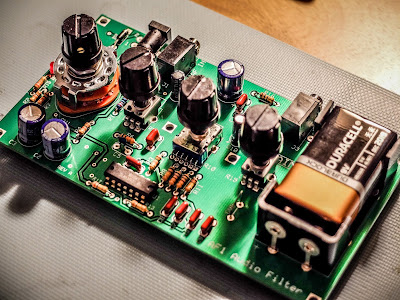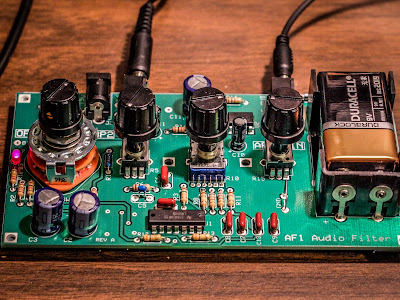Posts Tagged ‘Vintage HAM’
 Finer than a frog’s hair split twice
Finer than a frog’s hair split twice
Elecraft AF-1 Audio Filter Kit
I've been working a lot of SKCC CW stations during the holidays and adjacent stations really interfere with my ability to use the vintage Ten-Tec Century/21. Its built-in audio filter is relatively effective if the band isn't too crowded but if I'm working a station and others pop up within a 1kHz on either side I have a real hard time keeping track of which QSO to listen to. I wanted some relief from the relatively porous audio filtering provided by the old girl.
A kit from Elecraft seemed to be the ticket to better signal isolation for my old radio.
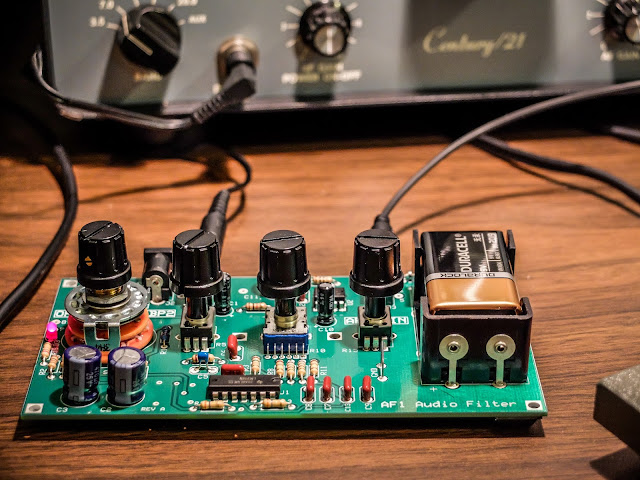 |
| Elecraft AF-1 Audio Filter Kit |
Building the kit
This kit is about $60 and is pretty easy to build There are a couple of ICs to solder so it will be easier if you have a temperature controlled, fine tipped soldering iron. Santa brought me a nice soldering iron for Christmas so this was my first chance to make some use of it. Everything about the kit is very straightforward and Elecraft has wonderful build instructions along with a well laid out board. Their instructions list components in the order that you will be installing them on the board, left to right and even include the color coding or numbering for resistors and capacitors right there in the instructions so you don't have to keep going back to look up the coding. I've only built one other kit previously and the Elecraft instructions are better.
My only gripe is that this kit has been out for quite some time, but for some reason they shipped me a Version "A" board that required a trace to be cut and a couple of jumpers installed to correct a board error. I would hope that they would ship new versions of the board but apparently you can get an old version. Next time I order a kit from them I may specify that I want the latest revision of the kit.
Performance
The board powered up and worked right as the last of the solder smoke was wafting away. I connected it to the Ten-Tec and tried to find some adjacent station operations to test against but the bands were not terribly busy tonight. I did manage to get a decent audio test on a calling station and created a video to demonstrate the board's capabilities.
Summary
This is the first kit I've built from Elecraft. It was a simple one. The instructions were excellent, the silkscreen layout on the board was straightforward and all the parts were in the bag. The kit does not come with an enclosure so it looks a bit unfinished and the knobs are a bit wobbly on their tall, plastic shafts. That is my only negative concern regarding the finished kit. Putting it in an enclosure would also require the battery holder to be moved to the bottom of the board to clear the shafts exiting the top of an enclosure. Certainly not a big deal but I would be willing to pay an extra $10 for a ready made enclosure because when I've tried to make them they look like junk.
But the bottom line is that if you have an older radio that lacks good filtering or you've built a homebrew radio that you want to be more usable on the air, the Elecraft AF-1 is an excellent addition. I think it is going to serve me well with my vintage radio. Now to find a project box to fit it.
That's all for now
So lower your power and raise your expectations
73/72
Richard, N4PBQ
 Don’t Bug OUT when hearing a Vibroplex semi-automatic key
Don’t Bug OUT when hearing a Vibroplex semi-automatic key
Vibroplex Bug Morse Keys
Since starting to work CW on-air a few months back I became familiar with the sound of other operators using Vibroplex Bug telegraph keys. I have been curious to try one of these semi-automatic keys even though I know that they are not recommended for new operators.
 |
| Vibroplex Original Semi-automatic Bug |
The Bug uses a sprung pendulum to automatically send DITS. The action of moving the lever to the right starts the pendulum in motion and it creates evenly timed DITS automatically. DAHS are created by manual timing moving the key to the left. Using the key requires quite a bit more practice that using a straight key or paddles.
The Vibroplex semi-automatic Bug is considered a manual key by the SKCC (Straight Key Century Club) so it counts in SKCC contacts.
Used Bugs in decent working condition can often be had for under $70. This one was advertised as being "un-used new in box". Indeed, when I received it, it still had the shipping bumpers on the main spring and still had shipping grease. The glue on the nameplate had deteriorated and come loose and there was significant oxidation on the parts. This bug is a few decades old but that doesn't matter because Vibroplex bugs haven't changed much in design since 1907. The history of their creator, Horace Martin is interesting. He created the bug to help deal with his own degraded sending ability due to long hours operating a straight key as a renowned telegrapher.
Horace was a professional telegrapher so he designed the bug for professionals who sent at speeds well above what is normally used in amateur radio. The slowest speed this bug can send DITS without modification is about 25wpm and goes well above 40wpm.
As a beginning CW operator you will generally be well below that speed in your copy skills and likely your sending speed as well. But when experienced hams work you with a bug they will slow their DAHS down to your speed, however without special added weights there's not much they can do to slow down their DITS to your speed. This gives their FIST a unique sound. The DAHS are sent slowly but the DITS are zinging by. When you first hear this style your brain will not know how to interpret what you hear but give it some time and you will learn to copy them.
You can slow the Bug down by adding weight to the end of the pendulum. An inexpensive method is to wrap the weight with some solder. I've wrapped mine to bring it down to about 22wpm.
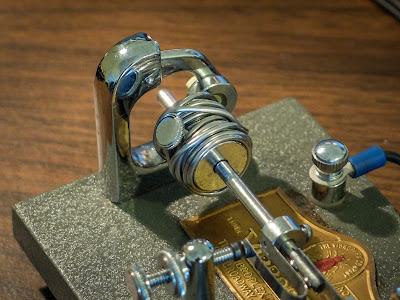 |
| Wrap the pendulum weight with solder to slow it a bit |
Here is a little video letting you hear a bit of the cadence of the bug. Now I just received this thing today and I practiced with it for about 30 minutes before making this video so I'm no bug operator for sure but it will give you some idea of the bug "swing"...
Here is a video running through the keys to see if learning a Vibroplex messes up my ability to use a paddle with an electronic keyer The Vibroplex Bug next to a Kent Hand Key. 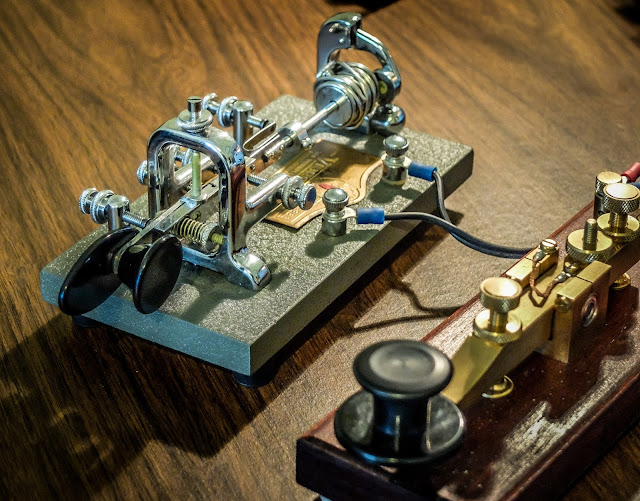 |
| Manual Morse Code Keys |
So don't "bug out" when you hear one of these on the air.
That's all for now
So lower your power and raise your expectations
73/72
Richard - N4PBQ
